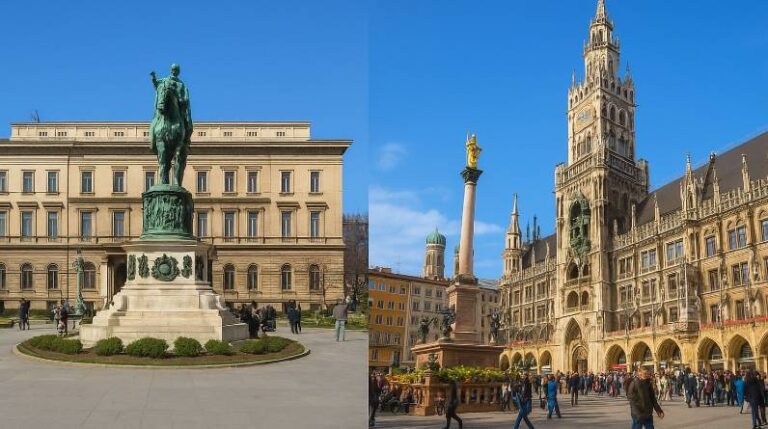маријин трг is more than just a public square — it is a living chronicle of urban identity, a stage for social connection, and a mirror reflecting centuries of history and change. Whether in the bustling center of Belgrade or within the historical context of European city squares like Munich’s Marienplatz, маријин трг stands as a symbol of resilience, cultural exchange, and community life.
This article takes you beyond the usual tourist descriptions, offering a deep dive into the square’s origins, transformation, cultural role, and evolving significance in modern urban planning.
A Tale of Two Histories: Shared Name, Distinct Legacies
The name маријин трг is associated with multiple European locations — most prominently:
| Location | Historical Roots | Signature Landmark |
| Belgrade, Serbia | 19th-century public space in the Kingdom era | Mariinski Palace |
| Munich, Germany | Founded in 1158 as a central marketplace | Mariensäule (Column of the Virgin Mary) |
This linguistic and cultural overlap reveals how European cities often carry parallel historical narratives through shared place names, while each location develops a unique personality.
Historical Layers of маријин трг (Belgrade)
Origins in the 19th Century
Emerging in the 1800s as an open civic space, Belgrade’s маријин трг became a venue for royal processions, public speeches, and marketplaces. The construction of the Mariinski Palace cemented its symbolic role as a seat of political and ceremonial life.
Role Through Social Change
From royal gatherings to political demonstrations, the square has adapted to Serbia’s shifting political landscape. Its architecture reflects styles from neoclassicism to modernist refurbishments, providing a physical timeline of the city’s growth.
Munich’s Marienplatz: A Name Twin with a Medieval Soul
While Belgrade’s version flourished in the 19th century, Munich’s Marienplatz dates back to the Middle Ages. Originally a grain market (Schrannenplatz), it evolved into a ceremonial hub. Key milestones include:
1638 – Installation of the Mariensäule, celebrating the end of Swedish occupation.
1972 – Pedestrianization during the Munich Olympics, reshaping it into a modern urban core.
2020 – Attracted over 12 million visitors, underscoring its global appeal.
Architectural Highlights
Belgrade’s Landmarks
Mariinski Palace – A neoclassical gem that anchors the square and serves as a historical governance site.
Cultural Institutions – Surrounding galleries and theaters foster a vibrant arts scene.
Green Corners – Landscaped spaces that balance stone and foliage, offering pockets of calm.
Munich’s Icons
New Town Hall (Neues Rathaus) – Gothic revival architecture featuring the world-famous Glockenspiel.
Old Town Hall – Rebuilt after WWII, maintaining its medieval charm.
Christmas Market – A centuries-old tradition that transforms the square into a festive wonderland.
The Square as a Cultural Catalyst
Events that Define the Space
Belgrade: Hosts art exhibitions, street performances, and seasonal markets, nurturing local creativity.
Munich: Stages tournaments, holiday markets, and open-air concerts that preserve Bavarian traditions.
Social Interaction Zones
Both squares serve as informal “urban living rooms”, where residents:
Meet friends
Watch impromptu performances
Participate in civic life
Urban Planning and Sustainability
Modern urban strategies treat маријин трг not just as a monument but as a multi-functional public space. Initiatives include:
Expanding pedestrian zones
Incorporating green infrastructure
Hosting eco-friendly events
Example: Belgrade’s recent plans for improved green coverage parallel Munich’s post-Olympic pedestrianization, showing how historic spaces can adapt without losing their soul.
Why маријин трг Matters Today
| Value Category | Belgrade’s маријин трг | Munich’s Marienplatz |
| Historical Education | Chronicles 19th-century Serbia | Preserves medieval Bavarian life |
| Tourism Magnet | Cultural festivals, Mariinski Palace | Christmas Market, Glockenspiel |
| Community Role | Local gathering hub | International meeting point |
| Economic Impact | Boosts small businesses, cafes | Fuels retail and hospitality |
Insider Tips for Visiting
Belgrade’s маријин трг
Start Early – Enjoy morning light for photography without crowds.
Attend a Festival – Check local listings for music or art events.
Explore Nearby – Walk to Kalemegdan Fortress or Skadarlija for a full-day cultural immersion.
Munich’s Marienplatz
Time Your Visit – Watch the Glockenspiel at 11 a.m. or 12 p.m.
Seasonal Magic – Visit in December for the Christmas Market.
Shop Local – Stroll pedestrian streets for Bavarian crafts.
маријин трг as a Living Bridge
Most articles focus on either the historical romance or the tourist appeal of маријин трг. The overlooked truth is that these squares function as living bridges between:
Past and present
Local identity and global influence
Tradition and innovation in public space design
Both in Belgrade and Munich, маријин трг is not a static landmark. It’s an evolving entity, adapting to the needs of its time while holding on to the essence that made it central in the first place.
Quick Facts at a Glance
| Feature | Belgrade’s маријин трг | Munich’s Marienplatz |
| Established | 19th century | 1158 |
| Signature Monument | Mariinski Palace | Mariensäule |
| Notable Event | Cultural festivals | Glockenspiel shows |
| Accessibility | Tram, bus, pedestrian paths | U-Bahn, tram, pedestrian area |
Final Thoughts
маријин трг is not just a square — it’s a sensory experience layered with history, art, and community energy. Whether you find yourself in Belgrade, feeling the hum of local life against the backdrop of the Mariinski Palace, or in Munich, standing beneath the chiming Glockenspiel, the essence is the same: a gathering place where a city’s heart beats in the open air. For travelers, urbanists, and historians alike, маријин трг offers both a glimpse of the past and a vision for the future of public spaces.
FAQs
Q1: Where is маријин трг located?
маријин трг refers to public squares in different cities, most notably in Belgrade, Serbia, and Munich, Germany (Marienplatz). Each has its own unique history and attractions.
Q2: What is the historical significance of маријин трг in Belgrade?
Belgrade’s маријин трг dates back to the 19th century and is home to the Mariinski Palace, serving as a political, cultural, and social hub.
Q3: What are the main attractions of Munich’s Marienplatz?
Munich’s Marienplatz is famous for the New Town Hall, the Glockenspiel, the Column of the Virgin Mary (Mariensäule), and its lively Christmas Market.
Q4: How do I get to маријин трг?
Both Belgrade’s and Munich’s squares are centrally located and easily accessible by public transport, including trams, buses, and metro systems.
Q5: When is the best time to visit маријин трг?
In Belgrade, spring and autumn offer pleasant weather for exploring. In Munich, December is ideal for enjoying the Christmas Market, while summer is great for open-air events.
Q6: Are there guided tours available?
Yes. Both cities offer walking tours that cover the history, architecture, and cultural highlights of маријин трг.
For more insightful articles and the latest updates, keep visiting Hacoo.

